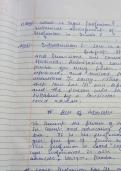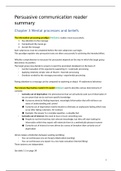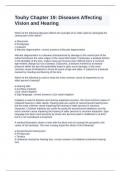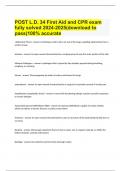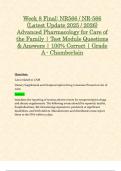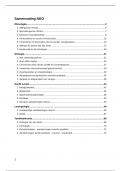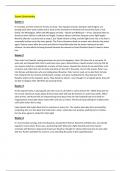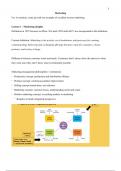Book Summary
The Principles of Communication
Nikki van Rooy
,Chapter 5
Encoding Messages
Nonverbal Communication (110-131)
Even when we are silent, invisible messages crowd around us: color excite us, sounds calm
us, the smell or look or feel of another human attracts or repels us.
Most communication experts say “you cannot not communicate”. Even if you don’t respond
to someone or don’t do anything, that’s still communicating. Nonverbal communication is
communication that occurs without words.
Examples:
- Your facial expression can indicate whether you’re happy or sad.
- Your clothes can give people a rough idea of your income
- Your posture and body type can tell onlookers your level of confidence and fitness.
- Your gaze can signal whether you are alert or distracted.
Even the way you walk can communicate a message, a message that keep you safe or put
you in danger. It can also make us more successful and effective in other contexts. People
can be taught to behave in ways that make them less vulnerable, but only if they are aware
of the messages their bodies send.
What counts as a nonverbal message and what doesn’t?
Someone is communicating when they are intentionally creating a message for someone.
Behavior is when someone is doing something unintentionally without wanting to
communicate. Mostly when they are alone. When they are among people, the people might
receive that behavior as a message of communicating.
How can we know what Nonverbals mean?
We take steps to increase our chances of making correct interpretations.
- Check the context
- Compare current behavior to baseline behavior
- Ask for verbal feedback
Characteristics of nonverbal communication
Nonverbal communication may be unintentional.
- As receivers, we should not assume that every nonverbal act is an intentional
message.
- As senders, we should be aware that unintended nonverbal messages can easily
undermine and contradict what we want to convey.
Nonverbal communication is immediate, continuous, and natural.
- Because nonverbals are physical extensions of our bodies, they are immediate.
- Most of the time we can’t delay nonverbal messages.
- Nonverbal displays flow into one another without discrete beginnings and endings
that characterize words.
- Nonverbal messages are more natural and less arbitrary than their verbal
counterparts. In most, form and meaning are connected.
,Nonverbal communication is both universal and Cultural.
- Many nonverbals are understandable the world over. We can communicate
nonverbally with people whose verbal language we don’t know.
- Not all nonverbal behaviors, however, have universal meaning. Even emotional
displays are modified by cultural rules. Do not assume that everyone shares your own
nonverbal rules.
Nonverbal communication consists of multiple codes.
- When nonverbal codes work together to send the same message, their impact is
intensified. When they work at cross-purposes, it can be confusing. Don’t let a
confident smile get undermined by nervous foot tapping.
What meanings are best conveyed (overgebracht) nonverbally?
What may be expressed easily in one may often be quite difficult to express in the other.
When something can’t be put in worlds, we turn to nonverbal channels.
Initial Judgements
Nonverbal cues are often used to size up other people. Nonverbal behaviors help us to
determine the credibility and approachability of those around us. With first impressions we
seldom give much information or dare to ask others about that, so we turn to nonverbal
channels.
Relational information.
After initial judgement, nonverbal cues convey relational information, helping us keep track
of how an interaction is going and what others think of us. 3 relational messages exchanged
nonverbally during every interaction:
- Liking, how to know if someone likes us by their nonverbal communication. Through
facial expression, eye contact, proximity, body language?
- Status, conveyed through posture and gesture, touch and proximity and by the
objects we display. The one who controls more space, initiates the most touch, and
seems the most relaxed is probably the one with the higher status.
- Responsiveness, the degree to which we are psychologically involved in an
interaction is shown by rate and volume of speech, amount of gestures and variability
, of facial display. Someone who responds to us in a monotone, staring straight ahead
with a dull expressionless look, is indicating low involvement and low responsiveness.
- Emotional Expression: when a child is frightened or unhappy, a comforting hug is
worth more than a verbal explanation of why it doesn’t help to cry. When we care
about someone, we want to reach out and touch them.
How are verbal and nonverbal messages related?
In most cases, verbal and nonverbal messages occur in combination. Nonverbal cues expand
on and clarify verbal messages. Sometimes we use nonverbal cues to repeat what we say
verbally. For example, if I give you directions I might point out where I want you to go. This
kind of redundancy helps to ensure that verbal messages are accurately received. Nonverbal
cues are also used to contradict verbal messages. Sarcastic comments are an example. The
words may be friendly, but the tone of voice gives the real message.
Sometimes nonverbal messages can substitute (vervangen) for verbal ones. We also use
substitution when verbal channels are unavailable. Nonverbal messages can also
complement. That is, modify or elaborate on, a verbal message. Nonverbal behaviors can
accent verbal interaction. They can also regulate, or control, social interaction. Through
changes in speech tempo, eye contact, head nodding and the like, we manage
conversations. If we raise our hand to get the chance to speak and the other person notices
this and speaks louder, we know our bid to talk has been turned down. Knowing the
meaning of and abiding by these nonverbals are aspects of the important interpersonal skill
called interaction management.
Channels of the nonverbal system
Body movement and gesture
The study of body movement (including face and eyes) is called kinesics. People who study
kinesics often classify body movement into five categories: emblems, illustrators, regulators,
affects displays, and adaptors.
The Principles of Communication
Nikki van Rooy
,Chapter 5
Encoding Messages
Nonverbal Communication (110-131)
Even when we are silent, invisible messages crowd around us: color excite us, sounds calm
us, the smell or look or feel of another human attracts or repels us.
Most communication experts say “you cannot not communicate”. Even if you don’t respond
to someone or don’t do anything, that’s still communicating. Nonverbal communication is
communication that occurs without words.
Examples:
- Your facial expression can indicate whether you’re happy or sad.
- Your clothes can give people a rough idea of your income
- Your posture and body type can tell onlookers your level of confidence and fitness.
- Your gaze can signal whether you are alert or distracted.
Even the way you walk can communicate a message, a message that keep you safe or put
you in danger. It can also make us more successful and effective in other contexts. People
can be taught to behave in ways that make them less vulnerable, but only if they are aware
of the messages their bodies send.
What counts as a nonverbal message and what doesn’t?
Someone is communicating when they are intentionally creating a message for someone.
Behavior is when someone is doing something unintentionally without wanting to
communicate. Mostly when they are alone. When they are among people, the people might
receive that behavior as a message of communicating.
How can we know what Nonverbals mean?
We take steps to increase our chances of making correct interpretations.
- Check the context
- Compare current behavior to baseline behavior
- Ask for verbal feedback
Characteristics of nonverbal communication
Nonverbal communication may be unintentional.
- As receivers, we should not assume that every nonverbal act is an intentional
message.
- As senders, we should be aware that unintended nonverbal messages can easily
undermine and contradict what we want to convey.
Nonverbal communication is immediate, continuous, and natural.
- Because nonverbals are physical extensions of our bodies, they are immediate.
- Most of the time we can’t delay nonverbal messages.
- Nonverbal displays flow into one another without discrete beginnings and endings
that characterize words.
- Nonverbal messages are more natural and less arbitrary than their verbal
counterparts. In most, form and meaning are connected.
,Nonverbal communication is both universal and Cultural.
- Many nonverbals are understandable the world over. We can communicate
nonverbally with people whose verbal language we don’t know.
- Not all nonverbal behaviors, however, have universal meaning. Even emotional
displays are modified by cultural rules. Do not assume that everyone shares your own
nonverbal rules.
Nonverbal communication consists of multiple codes.
- When nonverbal codes work together to send the same message, their impact is
intensified. When they work at cross-purposes, it can be confusing. Don’t let a
confident smile get undermined by nervous foot tapping.
What meanings are best conveyed (overgebracht) nonverbally?
What may be expressed easily in one may often be quite difficult to express in the other.
When something can’t be put in worlds, we turn to nonverbal channels.
Initial Judgements
Nonverbal cues are often used to size up other people. Nonverbal behaviors help us to
determine the credibility and approachability of those around us. With first impressions we
seldom give much information or dare to ask others about that, so we turn to nonverbal
channels.
Relational information.
After initial judgement, nonverbal cues convey relational information, helping us keep track
of how an interaction is going and what others think of us. 3 relational messages exchanged
nonverbally during every interaction:
- Liking, how to know if someone likes us by their nonverbal communication. Through
facial expression, eye contact, proximity, body language?
- Status, conveyed through posture and gesture, touch and proximity and by the
objects we display. The one who controls more space, initiates the most touch, and
seems the most relaxed is probably the one with the higher status.
- Responsiveness, the degree to which we are psychologically involved in an
interaction is shown by rate and volume of speech, amount of gestures and variability
, of facial display. Someone who responds to us in a monotone, staring straight ahead
with a dull expressionless look, is indicating low involvement and low responsiveness.
- Emotional Expression: when a child is frightened or unhappy, a comforting hug is
worth more than a verbal explanation of why it doesn’t help to cry. When we care
about someone, we want to reach out and touch them.
How are verbal and nonverbal messages related?
In most cases, verbal and nonverbal messages occur in combination. Nonverbal cues expand
on and clarify verbal messages. Sometimes we use nonverbal cues to repeat what we say
verbally. For example, if I give you directions I might point out where I want you to go. This
kind of redundancy helps to ensure that verbal messages are accurately received. Nonverbal
cues are also used to contradict verbal messages. Sarcastic comments are an example. The
words may be friendly, but the tone of voice gives the real message.
Sometimes nonverbal messages can substitute (vervangen) for verbal ones. We also use
substitution when verbal channels are unavailable. Nonverbal messages can also
complement. That is, modify or elaborate on, a verbal message. Nonverbal behaviors can
accent verbal interaction. They can also regulate, or control, social interaction. Through
changes in speech tempo, eye contact, head nodding and the like, we manage
conversations. If we raise our hand to get the chance to speak and the other person notices
this and speaks louder, we know our bid to talk has been turned down. Knowing the
meaning of and abiding by these nonverbals are aspects of the important interpersonal skill
called interaction management.
Channels of the nonverbal system
Body movement and gesture
The study of body movement (including face and eyes) is called kinesics. People who study
kinesics often classify body movement into five categories: emblems, illustrators, regulators,
affects displays, and adaptors.

